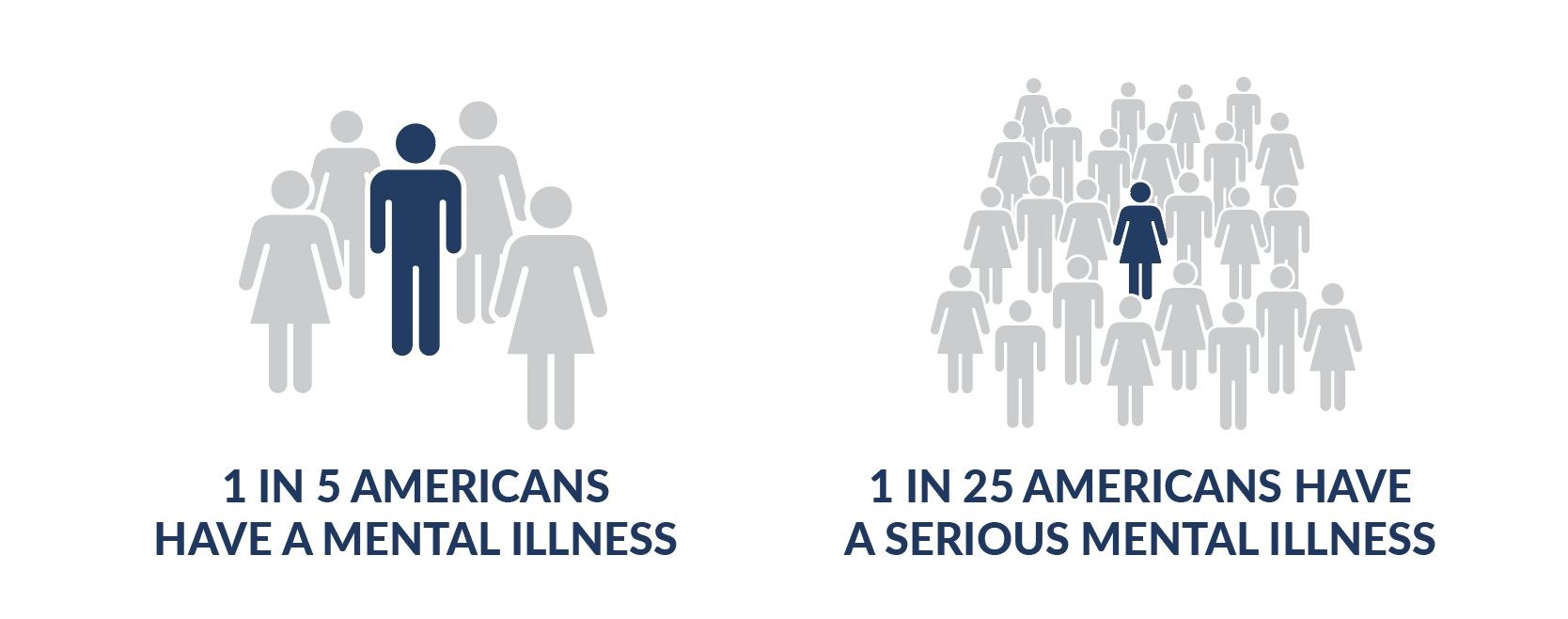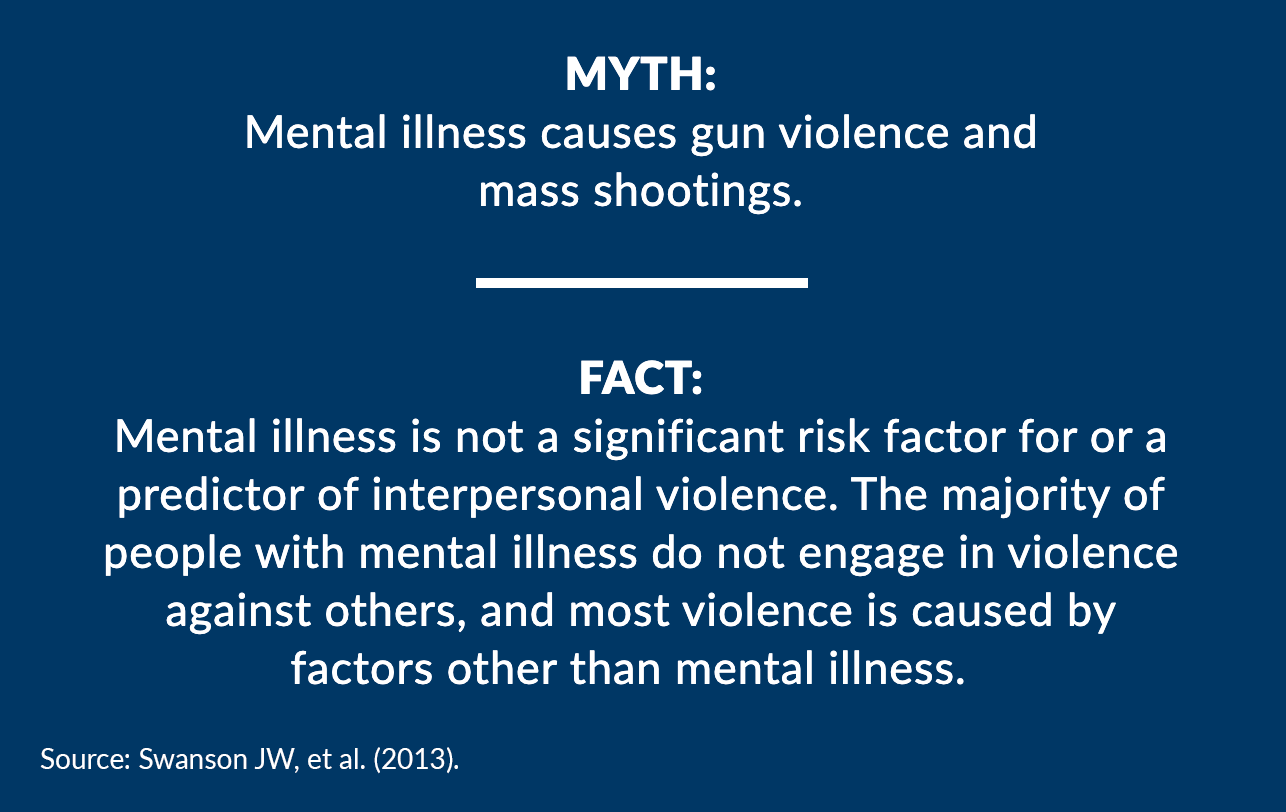Mental Illness and Gun Violence
Background
Many Americans live with mental illness. Indeed, around one in five Americans (43.4 million) have a diagnosed mental illness in a given year and one in 25 Americans (9.8 million) have a serious mental illness, such as schizophrenia or bipolar disorder.1
It is critical to understand that mental illness is not the cause of gun violence. The United States has similar rates of mental illness to other countries but much higher rates of gun violence.2,3 The firearm homicide rate in the U.S. is nearly 25 times higher than other high-income countries and the firearm suicide rate is nearly 10 times that of other high-income countries. Overall rates of gun deaths are 11.4 times higher in the U.S. as compared to other high-income countries.4
Violence has many contributing risk factors and mental illness alone is very rarely the cause. Only 4% of interpersonal violence in the United States is solely attributable to mental illness.5 Indeed, people with mental illness are more likely to be victims of interpersonal violence than perpetrators of violence.6 Similarly, there is no one single cause of suicide. While mental illness, specifically depression, is a risk factor for suicide, not everyone who experiences suicidality or dies by suicide has a mental illness. It is estimated that more than half of all suicide decedents did not have a known mental health diagnosis at the time of their death.7 People who die by firearm suicide are even less likely to have a diagnosis.8 Research also has found that mental illness is only weakly correlated with suicidal thoughts and behavior.9
Gun violence prevention policies that focus solely on a mental health diagnosis will not stop gun violence. Instead, these policies fuel prejudice and fear around people living with a mental illness and could lead to people avoiding mental health services.
What is mental illness?
The Centers for Disease Control and Prevention (CDC) defines mental illnesses as “conditions that affect a person’s thinking, feeling, mood, or behavior.”18
What is serious mental illness?
The CDC defines serious mental illness as “a mental illness or disorder with serious functional impairment that substantially interferes with or limits one or more major life activities.”19

Interpersonal Violence And Mental Illness
After mass shootings and other widely publicized shootings, people often blame mental illness as the cause of gun violence. It is common to read reports that describe the shooter as “psychotic” or “mentally disturbed.” These shootings capture the public’s attention and reinforce the harmful myth that mental illness causes violent behavior.
We know that is not the case.
Research consistently shows that the majority of people living with mental illness, including those with serious mental illness, are not violent towards others.20,21 In fact, people with mental illness are more likely to be victims of interpersonal violence than perpetrators.22
There are certain times, in certain settings, when small sub-groups of people with serious mental illness are at elevated risk of violence, such as the period surrounding a psychiatric hospitalization or first episode of psychosis.23,24 Still, only a very small proportion of interpersonal violence in the United States – about 4% – is attributable to mental illness alone.25 This means that if we were to somehow “cure” mental illness nationwide, we would still be left with 96% of interpersonal violence.
Attributable Risk of Violent Behavior Toward Others
Other risk factors
96%
Serious mental illness
4%
Source: Swanson JW, McGinty EE, Fazel S, & Mays VM. (2014). Mental illness and reduction of gun violence and suicide: Bringing epidemiologic research to policy. Annals of Epidemiology.
Unfortunately, we continue to see policy proposals for firearm restrictions based on mental illness diagnoses. Policies that restrict access to guns based solely on diagnosis are not only stigmatizing, but will not significantly reduce overall rates of gun violence in the United States.26,27
Instead of focusing on mental illness, policies and programs to reduce gun violence should focus on evidence-based, behavioral risk factors for future violence, such as past violent behavior,28 domestic violence,29 risky substance use,30,31 and risky alcohol use.32 Other risk factors for violence related to life experiences, personality, and identity that can be helpful markers for support and prevention programs include exposure to violence,33 being male,34 being young,35 and impulsive anger.36
“The terms we hear from people on both sides of the aisle, such as ‘the dangerously mentally ill,’ are misleading, damaging to the mental health community, and not based on evidence. The gun lobby, politicians, and the ill-informed media have conditioned us to associate mental illness with violence. The idea that mentally ill means violent is an alternative fact. Period.”
- Josh Horwitz, Executive Director
Suicide And Mental Illness
Suicide is the second leading cause of death among young adults aged 25-34, and the 10th leading cause of death among all Americans.37 Making up three-fifths of gun deaths, suicide is a major contributor to the gun violence epidemic.38
There is no one single cause of suicide, and while mental illness is a risk factor for suicide, not everyone who is experiencing suicidality or dies by suicide has a mental illness. In fact, mental illness is only weakly correlated with suicidal thoughts and behavior.39,40 It is estimated that more than half of all suicide decedents did not have a known mental health diagnosis at the time of their death and that firearm suicide decedents were even less likely to have a diagnosis.41 As such, the mental health system alone is not an effective pathway for preventing firearm suicide.42 There is research to support the idea that, overall, access to more behavioral health treatment only has a small protective effect on the rate of firearm suicide.43
Suicide Decedents with Mental Health Conditions
Did have a known mental health condition
46%
Did not have a known mental health condition
54%
Source: Stone DM, Simon TR, Fowler KA, Kegler SR, Yuan K, et al. (2018). Vital Signs: Trends in state suicide rates — United States, 1999–2016 and circumstances contributing to suicide — 27 states, 2015. Morbidity Mortality Weekly Report.
Additionally, suicidal thoughts and behaviors often fluctuate over time. They are often prompted by difficult life situations which themselves may change over time. Such life stressors include relationship problems or rejection, financial and housing instability, criminal/legal troubles, death of a loved one, serious illness, trauma, physical or sexual abuse, family violence or distress/dysfunction, persecution, and other recent or impending crises. Impulsive or aggressive tendencies, risky alcohol or substance use, and easy access to lethal methods, such as firearms, also increase suicidal risk.44
Indeed, many research studies have shown that easy access to guns increases risk of suicide.45,46,47,48,49,50,51,52,53,54,55,56,57,58,59,60,61
Ensuring that someone doesn’t have access to a firearm during a potential suicidal crisis, regardless of mental illness, can often be the difference between life and death.
Preventing suicide is an important part of gun violence prevention. However, focusing only on mental illness is not sufficient to prevent these deaths. To effectively prevent suicide, we must reduce easy access to guns, especially during periods of elevated risk.
Prevent Firearm Suicide
Prevent Firearm Suicide is a project of the Ed Fund that was developed to raise awareness about how temporarily reducing access to firearms during periods of high risk for suicide is life-saving. PreventFirearmSuicide.com shares effective, evidence-based interventions for firearm suicide prevention; information on the intersection of firearms and suicide including risk factors and statistics; state-level firearm suicide for all 50 states; and includes a robust resource library of educational materials, initiatives, research, and other resources about firearm suicide prevention and means safety. To learn more, please visit PreventFirearmSuicide.com and our page on firearm suicide.
Focusing on mental illness is problematic for gun violence prevention
Gun violence prevention policies that focus solely on a mental illness diagnosis will not stop gun violence and, instead, could fuel prejudice and fear around people living with a mental illness and may lead to people avoiding mental health services. We must dispel the myth that living with a mental illness makes you dangerous and likely to perpetrate violence towards others.

HATE IS NOT A MENTAL ILLNESS
Evidence shows that narratives surrounding shootings are different based on the race of the shooter. An analysis of 219 mass shootings and subsequent news coverage found that the shooters’ race strongly predicted whether the media discussed the shooters’ mental health.63 When a mass shooting was carried out by a White or Latino person, the media often attributed it to mental illness. White shooters, in particular, were framed as good people suffering from extreme life circumstances and were 19 times more likely to be framed as suffering from mental illness compared to Black shooters. Black and Latino perpetrators were more often portrayed as ongoing threats to public safety, while White perpetrators were viewed more sympathetically, putting the blame on mental illness and not on the individuals themselves.65
We know that hate is not a mental illness. We know that changing the narrative after a mass shooting based on the skin color of the perpetrator is both dangerous and factually incorrect. And yet, time and time again, the media is quick to call something “terrorism” if the perpetrator was Black, and quick to blame mental illness when the perpetrator was White.64,65
“Most of the time, mass shooters aren’t driven by delusions or voices in their head. They are driven by a need to wield their power over another group. They are angry at the perceived injustices that have befallen them at the hands of others — women who wouldn’t sleep with them, fellow students who didn’t appreciate their talents, minorities enjoying rights that were once only the privilege of white men like them. It’s not an altered perception of reality that drives them; it’s entitlement, insecurity, and hatred. Maybe some of them also have depression, ADHD, or anxiety, but that is not why they opened fire on a group of strangers.”
- Amy Barnhorst, Vice Chair for Community Mental Health in the Department of Psychiatry at the University of California, Davis and member of the Consortium for Risk-Based Firearm Policy
Stop the Stigma
When the media, politicians, or other public figures blame a shooter’s behavior on mental illness, they are stigmatizing and discriminating against the millions of Americans living with mental illness. Terms such as “the dangerously mentally ill” are misleading, disparaging, and not based on evidence.
The Educational Fund to Stop Gun Violence works to ensure that our messaging and policy recommendations do not stigmatize those living with mental illness. We know that mental illness diagnoses do not define people, and mental illness is not a choice. We can’t choose where we come from, we can’t choose what we look like, and we can’t choose whether or not to have a mental illness.
The way we talk about gun violence — and the laws that we support — should be based on facts, not falsehoods. To be effective, we must focus on dangerous behaviors — not diagnoses. By focusing on dangerous behaviors as established by research, we can make gun violence — including gun suicide — rare and abnormal.
Mental Health Consequences of Gun Violence
While the evidence is clear that mental illness is not the cause of gun violence, incidents of gun violence may cause mental health difficulties for survivors of gun violence. Mental health effects following gun violence may include depression, anxiety, trauma, post traumatic stress disorder, intrusive thoughts, sleep problems, and personality changes.66 Additionally, the trauma of gun violence can ripple out into the community, far beyond those who were shot or injured. Family members, friends, neighborhoods, communities, first responders, and health care providers may all experience adverse mental health effects.
RECOMMENDATIONS
Focus gun violence prevention policies on evidence-based risk factors — not mental illness. Use appropriate language and avoid harmful stereotypes.
Mental illness does not cause gun violence. Gun violence prevention policies should be evidence-based, promote public safety, and respect individuals with mental illness.
Firearm removal laws, like extreme risk protection orders, should not be based on a mental health diagnosis and should be based on risk factors for violence and overall dangerousness, like a history of violent behavior, domestic violence, and risky alcohol use.
The language we use when talking about mental illness should be judgment free and not reinforce stereotypes or negative beliefs.
How to talk about mental illness without the stigma:
| Problematic | Preferred |
|---|---|
| Mentally ill, mental defective | Person with mental illness |
| Person-first language is preferred. A diagnosis does not define an individual. | |
| Dangerously mentally ill | Person with serious (severe) mental illness |
| The word “dangerous” is stigmatizing, not based on facts, and not a clinical word. No person is dangerous purely because they have a serious mental illness. | |
Resources
Educational Materials
Fact sheets
Reports
- Consortium for Risk-Based Firearm Policy: Guns, Public Health, and Mental Illness: An Evidence-Based Approach for Federal Policy
- Consortium for Risk-Based Firearm Policy: Guns, Public Health, and Mental Illness: An Evidence-Based Approach for State Policy
Read More
- May 2019 Q&A, In My Voice: For Years, I Equated Mental Illness with Violence. I Was Wrong
- May 2019 Q&A, In My Voice: I Experienced Gun Violence Firsthand and Struggled with My Mental Health. Now I’m Working to Help Others Address Both
- May 2019 Q&A, In My Voice: Seeking Help and Navigating Discrimination as a Black, Female Therapist
- May 2019 Q&A, In My Voice: Decoupling Mental Illness and Violence as a Psychiatrist
- May 2019 blog, Recovering, Not Recovered
- March 2019 blog, It’s Time to Retire the Term “Red Flag Laws”
- January 2019 roundtable, Guns, Suicide, and Mental Illness: A Roundtable Discussion
- October 2018 blog, Don’t Call Us Dangerous. Don’t Call Us “the Mentally Ill”
- September 2018 blog, Six phrases that stigmatize suicide and mental illness
- September 2018 article in Channel 3000, Officials Warn Not to Jump to Conclusion that Middleton Shooting is Related to Mental Health
- May 2018 article in The Advocate, Why Didn’t Bizarre Behavior Block Man Accused in Lafayette Police Officer’s Death From Buying a Gun?
- March 2018 article in the New Yorker, A Glimmer of Hope in the Political Impasse on Gun Control
- February 2017 op-ed in the Huffington Post, We Can Stop Gun Violence Without Blaming People Living With Mental Illness
Research
- Appelbaum P & Swanson J. (2010). Law & psychiatry: gun laws and mental illness: how sensible are the current restrictions? Psychiatric Services.
- Choe JY, Teplin LA, & Abram KM. (2008). Perpetration of violence, violent victimization, and severe mental illness: balancing public health concerns. Psychiatric Services.
- Elbogen EB & Johnson SC. (2009). The intricate link between violence and mental disorder: results from the National Epidemiologic Survey on Alcohol and related conditions. Archives of General Psychiatry.
- Lu Y & Temple JR. (2019). Dangerous weapons or dangerous people? The temporal associations between gun violence and mental health. Preventive Medicine.
- McGinty EE, Webster DW, & Barry CL. (2013). Gun policy and serious mental illness: Priorities for future research and policy. Psychiatric Services.
- Metzl JM & MacLeish KT. (2015). Mental illness, mass shootings, and the politics of American firearms. American Journal of Public Health.
- Pescosolido BA, Manago B, & Monahan J. (2019). Evolving public views on the likelihood of violence from people with mental illness: Stigma and its consequences. Health Affairs.
- Swanson JW, Roberston AG, Frisman LK, Norko MA, Lin HJ, Swartz MS, & Cook PJ. (2013). Preventing gun violence involving people with serious mental illness. Reducing Gun Violence in America: Informing Policy with Evidence and Analysis.
- Swanson, JW, McGinty EE, Fazel S, & Mays VM. (2015). Mental illness and reduction of gun violence and suicide: bringing epidemiologic research to policy. Annals of Epidemiology.
- Van Dorn R, Volavka J, & Johnson N. (2012). Mental disorder and violence: is there a relationship beyond substance use? Social Psychiatry and Psychiatric Epidemiology.
Additional Resources
- American Psychological Association’s gun violence prevention resources
- Autistic Self Advocacy Network's “Make Real Change On Gun Violence: Stop Scapegoating People With Mental Health Disabilities”
- Bazelon Center for Mental Health Law's “Wrong Focus: Mental Health in the Gun Safety Debate”
- Coalition for Smart Safety and the Consortium for Citizens with Disabilities Rights Task Force's Debunking the Myths: Mental Health and Gun Violence
- Mental Health America’s “Position Statement 72: Violence: Community Mental Health Response”
- National Alliance on Mental Illness (NAMI)'s resources on Extreme Risk Protection Orders
- National Council of Behavioral Health
If you or someone you know needs some support now, please contact the National Suicide Prevention Lifeline at 1-800-273-TALK (8255) or text “HOME” to 741-741.
Last updated July 2020

